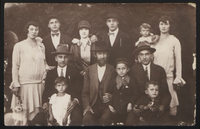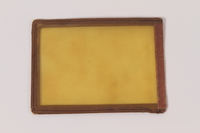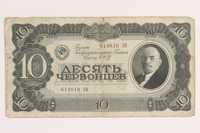Overview
- Brief Narrative
- Soviet bank note, 3 chervonets, issued 1937, acquired by 21-year old Ladislav Davidovic when he served in a Hungarian forced labor unit on the Russian front during World War II. Louis was from a region in Czechoslovakia that was annexed by Hungary in 1938. He was able to stay in school at the Jewish Gymnasium, but when he graduated in 1943, he was ordered into the Hungarian army, close allies of Nazi Germany. He was put in charge of a forced labor battalion of Jewish boys who were responsible for rebuilding bombed railroads on the eastern front during the German retreat from Russia. After liberation, Ladislav returned to find his family gone, so he went to Prague. He was eventually reunited with his father and mother, who had survived Auschwitz. The family emigrated to the United States in 1946.
- Date
-
issue:
1937
- Geography
-
use:
Russia
- Credit Line
- United States Holocaust Memorial Museum Collection, Gift of Deborah Kronenberger
- Markings
- face, upper center, in border, red ink : три [three]
face, upper center, red ink : Turem / Tocygapcmeeннoro / танка Сотоза CCP / три червонца [THREE CHERVONETSES]
face, center, behind text, red ink : три [three]
face, lower center, below text, red ink : BAKOBCKИE BИЛETЬl OBECПEЧИBAЮTCЯ ЗOЛOTOM ДPAГOЦEHHЫMИ METAЛЛAMИ И ЛPOЧИMИ AKTИBAMИ ГOCVДAPCTBEHHOГO BAHKA
face, upper right, black ink : 069042 цп
face, lower left, black ink : 069042 цп
back, center, printed, red ink : 3
back, center, below number, printed, black ink : 1937
back, lower center, printed, brown ink : три червонца [THREE CHERVONETSES]
back, left side, center, printed bold, brown ink : 3
back, right side, center, printed bold, brown ink : 3
back, center left, printed, brown ink : три ЧEPBOHEЦ / [?] / VC CERVON / UC CERVONS / VC CERVON(?)S [Three Chervonet]
back, center right, printed, brown ink : AДЗIH ЧЬIPBOHEЦ / [?] / VC CERVONS / SE CERVONS / VC CERVON - Contributor
-
Subject:
Louis Davis
- Biography
-
Ladislav Davidovic (Louis Davis) was born on May 27, 1923, in Belke, Czechoslovakia (Ukraine), part of the SubCarpathian Rus. His mother, Malvina Maizlik, was born on January 28, 1900, in Osry to a well-to-do family. She was the youngest of twelve siblings, with one sister and one brother living in the United States. His father, Yehuda-Yitzhak (Izák) Davidovic, was born on April 1, 1898, in Bilke. He was the eldest of three brothers: Schmuel, Herschel, married to Rose Stein, and Zeleg who ran a lumber and leather export firm, and two sisters, Fanny and Margaret, who lived in the US. His father was a prosperous banker, and also a biblical scholar with a Yeshiva education. Malvina and Isaac married on September 6, 1922 and resided in Belke.
In 1937, Louis was sent to the prestigious Hebrew Gymnasium in Munkacs (Mukecheve, Ukraine), where he became fluent in Hebrew and English. In 1938-1939, that region of Czechoslovakia was seized and annexed by Hungary, a longtime German ally. Laws stripped Jews of their rights and forced them out of many professions. Louis parent’s thought they would be able to ride out this surge of anti-Semitism, as Jews had done throughout history. His father had been a sergeant in the Hungarian Army during World War I and thought that also would help them stay safe. Izak was jailed for a short time, but was able to bribe officials and get released. Under the new laws, he was not allowed to have a business, so he found a non-Jew to act as the owner, and was able to still operate the business.
The Hebrew Gymnasium was closed with the arrival of the Hungarians in November 1938, but it was allowed to reopen in January 1939 as the Jewish Gymnasium. When Louis graduated in 1943, he was drafted into the army and told that he would be serving as an officer. When he arrived, he was ridiculed and humiliated for thinking a Jew could be an officer and wear a uniform. His uniform was ripped off him and his saber was replaced with a shovel. He was made leader of a forced labor squad of Jewish boys who were responsible for rebuilding bombed railroads on the Russian front line. Each day they would repair the lines and watch each night as they were bombed again. The workers were starved, overworked, and regularly beaten. But the laborers were aware of the concentration camps and would tell themselves, at least there are no crematoriums on the front lines. Louis later would be haunted by memories of a German soldier who regularly beat him while shouting: “When you are dead, I will take your nice teeth.” His mother had supplied him with dozens of sets of underwear, and though he protested that he did not want them, he was able to trade them for bread. She had also given him a big bottle of schmaltz [chicken fat] which he used sparingly, a drop at a time, to flavor rotten potatoes he found in the fields.
The Russians had been steadily advancing west toward Europe since the February 1943 defeat of the Germans in the Battle of Stalingrad. The liberation of the area where his squad was working was a time of terrifying confusion for Louis. At one point, he suddenly encountered his paternal uncle, Herschel. But as the Russian soldiers stormed through, shooting at anyone in their path, his uncle was hit by a piece of shrapnel and died in Louis’s arms. Louis was almost shot by one soldier, but he screamed Jid! Jid! [Jew Jew] and showed his Star of David badge, and the soldier took him to an officer who told him to get out. Louis fled, and though wounded by shrapnel in his back, made his way to Bilke. He found his home occupied by neighbors whose response, before shutting the door in his face, was surprise that he was not dead. He left his village, and was picked up by the Soviets for forced induction into the Army, but escaped and continued to Prague. He went to the American Embassy and was one of the first refugees to register to come to the United States. He was able to contact his paternal aunts in the US, to tell them he was alive. From talking to other survivors, all of whom seemed to be his own age, he was convinced that his parents and all his family were dead. All the young one and the old ones seemed to be gone.
Ladislav decided to enroll in medical school at Charles University with relief funds from the Joint Distribution Committee. One day at school, a group of students came running to tell him that his father was there looking for him. Yehudah had been at Auschwitz when it was liberated by the Soviet Army in January 1945. He and Ladislav’s mother had been sent to the Berehove ghetto in March 1944 when Germany occupied Hungary. By May, the Germans had begun systematic deportations of the Jewish population to concentration camps. Ladislav’s parents were sent to Auschwitz by cattle car. His grandfather went directly to the gas chambers; his parents were separated. Izák worked at the crematorium, pulling charred bodies out and loading new bodies in. He bribed the guards with his gold teeth to prevent himself from being killed. Rations were a piece of stale bread and hot water called soup. There were frequent inspections when the inmates had to stand naked in the snow as more selections were made to get rid of the sick and weak. After liberation, Yehudah set out looking for his family and finally met someone who knew that Ladislav was at school in Prague.
Once they were reunited, Ladislav and Yehudah searched for Malvina, but were not able to learn her fate. Then one day, they were waiting at a crowded railway station when Ladislav felt a tug on his sleeve and heard: “Loici, you are so beautiful.” It was his mother, emaciated, filthy, and very sick with pneumonia. She got hysterical when they tried to carry her little bundle of soap and bread. After a month in hospital, she began to recover her health. Malvina had witnessed the murder of her sister-in-law Rose in June/July 1944 and of Rose's husband, Herschel, in February 1945.Of her large family, only one niece, Rachel Rosenfeld, survived.
In 1946, the family emigrated to the US where Louis continued his studies and became a naturalized citizen in 1952. They changed their names to Joe, May, and Louis Davis. The family was dedicated to forgetting, but Louis was never free from nightmares. He died on March 3, 1994, age 71 years.
Physical Details
- Language
- Russian
- Classification
-
Exchange Media
- Category
-
Money
- Object Type
-
National bank notes (lcsh)
- Physical Description
- Rectangular bank note on white paper with Russian text. The face has a red inked rectangular, swirl patterned frame with the denomination 3 printed in scalloped corner medallions; the text denomination три [three] is printed within the top border. On the left is a large scalloped medallion with the denomination 3 in white on a green background. On the left is an oval medallion with a portrait of Lenin in a suit. The center of the rectangle is white with a faint green три [three] in the center with a superimposed три ЧEPBOHEЦ [Three Chervonet]. There is text above and below. On the upper left is the Soviet hammer, sickle, and star emblem within a wreath. The serial number 069042 цп is printed on the upper right and lower left. The reverse has a red, straight edged, patterned border with the numerical denomination 3 in scalloped corner medallions. A large 3 is printed in the center with the date 1937 below on a faint, ornate, swirled background design in purple, orange, and blue ink. On the left and right are 5 lines of text stating 1 Chervonet in 10 languages. The note is creased and wrinkled.
- Dimensions
- overall: Height: 3.500 inches (8.89 cm) | Width: 6.750 inches (17.145 cm)
- Materials
- overall : paper, ink
Rights & Restrictions
- Conditions on Access
- No restrictions on access
- Conditions on Use
- No restrictions on use
Keywords & Subjects
- Topical Term
- Forced labor--Hungary--Biography. Holocaust, Jewish (1939-1945)--Czechoslovakia--Personal narratives, Jewish. Jews--Persecution--Czechoslovakia. World War, 1939-1945--Conscript labor--Hungary--Personal narratives, Jewish. World War, 1939-1945--Campaigns--Eastern front--Personal narratives, Jewish.
Administrative Notes
- Legal Status
- Permanent Collection
- Provenance
- The paper money was donated to the United States Holocaust Memorial Museum in 2005 by Deborah Kronenberger, the daughter of Louis Davis.
- Record last modified:
- 2023-06-21 11:44:51
- This page:
- https://collections.ushmm.org/search/catalog/irn517289
Download & Licensing
In-Person Research
- By Appointment
- Request 21 Days in Advance of Visit
- Plan a Research Visit
- Request to See This Object
Contact Us
Also in Louis Davis collection
The collection consists of four Soviet currency notes, a document case, documents, and photographs relating to the experiences of Louis Davidovic (David) and his family in Czechoslovakia before, during, and after the Holocaust, including the years Louis spent in a Hungarian forced labor battalion on the eastern front in Russia.
Date: 1936-1948

Louis Davis papers
Document
The Louis Davis papers contain records related to Louis Davis (Ladislav Davidovic), a Jewish man who was drafted into the Hungarian army, put into forced labor on the front lines against the Soviet Army, and after the war enrolled into university. The papers document mainly his time post-war, and contain diplomas, course listings, and other material from his time at University of Cluj and Charles University. Other items include his birth certificate, passports, and other forms of identification. Also included are photographs of Ladislav and his family. The Louis Davis papers contain material related primarily to Louis’ time at university after World War II. Included in the records are a lesson book and letter of acceptance to University of Cluj, confirmation of enrollment, registration, and list of courses from Charles University, and in an oversized folder are his diplomas from the Munkacs Hebrew Gymnasium. Also included are passports for his family, his birth certificate, and a repatriation certificate. The correspondence are from Rosh Pinna and Lord Byron Rotherwer. There are also photographs of Louis and his family, though many are not labeled.

Plastic document case used by a former Hungarian Jewish forced laborer
Object
Document case used by 21-year old Ladislav Davidovic who served in a Hungarian forced labor unit on the eastern front in 1943. He kept his school records with him through the war, perhaps in this document case, where they stayed safe until liberation. Ladislav was from a region in Czechoslovakia that was annexed by Hungary in 1938. He was able to continue at the Jewish Gymnasium, but when he graduated in 1943, he was ordered into the Hungarian army, close allies of Nazi Germany. He was put in charge of a forced labor squad of Jewish boys who were responsible for rebuilding bombed railroads on the eastern front during the German retreat from Russia. After liberation, Louis returned to find his family gone, so he went to Prague. He was eventually reunited with his father and mother, who had survived Auschwitz. The family emigrated to the United States in 1946.

Soviet Union, 10 chervonets note, acquired by a Hungarian Jewish forced laborer
Object
Soviet bank note, 10 chervonets, issued 1937, acquired by 21-year old Ladislav Davidovic when he served in a Hungarian forced labor unit on the Russian front during World War II. Louis was from a region in Czechoslovakia that was annexed by Hungary in 1938. He was able to stay in school at the Jewish Gymnasium, but when he graduated in 1943, he was ordered into the Hungarian army, close allies of Nazi Germany. He was put in charge of a forced labor battalion of Jewish boys who were responsible for rebuilding bombed railroads on the eastern front during the German retreat from Russia. After liberation, Ladislav returned to find his family gone, so he went to Prague. He was eventually reunited with his father and mother, who had survived Auschwitz. The family emigrated to the United States in 1946.

Soviet Union, 10 chervonets note, acquired by a Hungarian Jewish forced laborer
Object
Soviet bank note, 10 chervonets, issued 1937, acquired by 21-year old Louis Davis when he served in a Hungarian forced labor unit on the Russian front during World War II. Louis was from a region in Czechoslovakia that was annexed by Hungary in 1938. He was able to stay in school at the Jewish Gymnasium, but when he graduated in 1943, he was ordered into the Hungarian army, close allies of Nazi Germany. He was put in charge of a forced labor battalion of Jewish boys who were responsible for rebuilding bombed railroads on the eastern front during the German retreat from Russia. After liberation, Louis returned to find his family gone, so he went to Prague. He was eventually reunited with his father and mother, who had survived Auschwitz. The family emigrated to the United States in 1946.
Soviet Union, 3 chervonets note, acquired by a Hungarian Jewish forced laborer
Object
Soviet bank note, 3 chervonets, issued 1937, acquired by 21-year old Ladislav Davidovic when he served in a Hungarian forced labor unit on the Russian front during World War II. Louis was from a region in Czechoslovakia that was annexed by Hungary in 1938. He was able to stay in school at the Jewish Gymnasium, but when he graduated in 1943, he was ordered into the Hungarian army, close allies of Nazi Germany. He was put in charge of a forced labor battalion of Jewish boys who were responsible for rebuilding bombed railroads on the eastern front during the German retreat from Russia. After liberation, Ladislav returned to find his family gone, so he went to Prague. He was eventually reunited with his father and mother, who had survived Auschwitz. The family emigrated to the United States in 1946.



